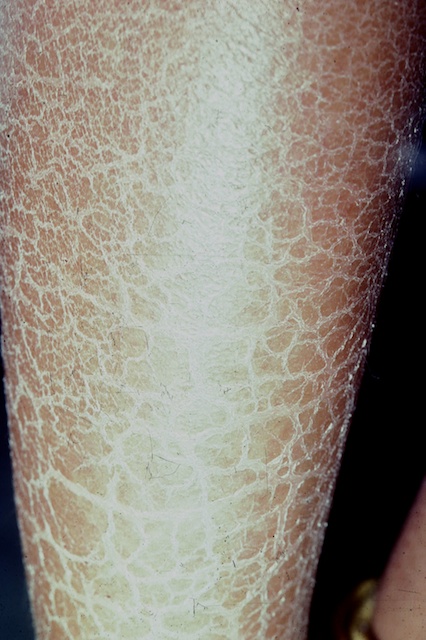Ichthyosis is the term used for a family of skin conditions that are characterized by a thickened stratum corneum and/or visible scales covering most or all of the body surface. Most ichthyoses are inherited – yet paradoxically, often people with ichthyosis know of no one else in their families with their condition. This can happen if the genetic change that produces the skin condition began with them – that is, if it was a new mutation. It can also happen in those forms that have a recessive inheritance. Recessive conditions are those that require that both copies of a gene, (both copy of the gene inherited from the mother and the one from the father), to be mutated before the condition manifests.

The genetic forms of ichthysosis vary from relatively common (~1 in 250 persons) to rare. Many people who have severe dry skin may indeed have a form called ichthyosis vulgaris. And in some of the rarer inherited types, other organs of the body may be affected, as well. Sometimes ichthyosis is not inherited, but is ‘acquired’, meaning that it is due to some other medical condition, or is caused by a medication or a dietary deficiency. Most of the inherited forms of ichthyosis begin early in life, while those due to acquired causes may not appear until later on. A consultation with a dermatologist is recommended for those who think they may have one of these types of skin disorders.
The scaling in ichthyosis is often most prominent over the lower legs.Over 40 genes have been discovered that can cause ichthyosis. The study of these genes and what they do has been invaluable to our understanding of how skin normally sheds – the process of desquamation – and why dry skin looks ashy or flaky. They have also helped us to understand how the skin’s permeability barrier operates.
I have Lamellar Ichthyosis. I’ve had it since birth. I am now 46 yrs. old. I was wondering if I could find someone to contact with, & share my story with. It has gotten worse over the past several yrs. I hope I can find some one to talk to.
It may feel like it to you, but you are not alone. The best way for people who have rare or uncommon conditions, such as lamellar ichthyosis, to find others like them is through one of the patient support groups. People with ichthyosis are fortunate that there is a fantastic organization to help them – the Foundation for Ichthyosis and Related Skin Types (FIRST). If you haven’t already done so, visit their website, then become a member and receive their newsletter. You may even be able to attend one of their family conferences – often a life changing experience.
Oh my. I am so glad I found this site. I thought I had a bad case of eczema for years, but my legs looks similar to the one in the picture and my skin shedding has been getting worse, so I am definitely open to meeting others who also have this same condition and seeing if there’s anything I can do about. It’s beginning to affect me during the summer also, which has never been a problem for me until recently. Thanks. I look forward to hearing from you guys.
We are happy to hear that you found our website useful to you. Perhaps the FIRST website will be useful to you. For information on skin care practices that could be helpful, see our free brochure Taking Good Care of Your Skin.
Please send me any information on ichthyosis and what it affects in the body. Please, Doctors down here have not told me in 43 years, and now my son has it too. Thank you.
Thank you for your interest in our website. The Foundation for Ichthyosis and Related Skin Types or FIRST has a great deal information available on its website. A good way to stay in touch with the latest information on ichthyosis and to connect with others with the disorder is become a member of the Foundation and subscribe to their newsletter.